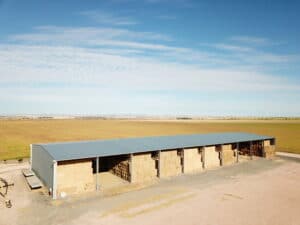The Australian climate in all its beauty can be harsh, building a hay shed can help you face some of the most extreme weather conditions.
It wasn’t too long ago we found ourselves amid some of the harshest drought conditions faced in the nation’s recorded history. During the winter of 2019, we saw the rainfall levels drop to the lowest 10% of historical records in some areas. Similarly, the March quarter of the new decade brought an array of extreme events, including severe droughts, bushfires, and an unprecedented pandemic. All of which had drastic effects on the cattle industry, with a lot of us feeling this hit.
Fast forward we’ve done amazing work and bounced back with tremendous resilience, with cattle demand on the rise – and consequently prices. A lucrative shift is in play, but proper preparation is pivotal.
Learning the lessons of the past, how can we take our situation today and establish safeguards that protect us from the unexpected as we move forward. Let’s dive into it:
Utilise Your Hay Shed

Control over hay is a massive factor in combating dry conditions, and 2019 solidified this notion even further. During severe drought conditions, hay became two things: scarce and ridiculously expensive.
A sure-fire way to avoid this unfavourable situation is to establish and operate your own hay shed. The reasons for this are:
1. Store Hay All Year-Round
Rain or shine, your hay will have a home preventing them from being weathered or wasted. Consequently, this gives the option to purchase more than you need now, taking advantage of favourable prices.
At Spanlift, we help to further facilitate this with our modular frame system with cleats and bolt holes. This feature makes your shed ready for future extensions and grows as your needs do. Similarly, where hay would ordinarily create a moisture trap around columns, our standard hot-dipped galvanised universal beam columns prevent this. Stopping any further damage, a clean and fresh year-round storage option is further facilitated.
2. Your Hay Shed Can Protect Your Assets from the Elements
Weather-damaged hay lacks nutrients and value overall. That’s why protection against the elements is massive when we’re talking about year-round storage. The aftermath of weather-affected hay can show:
-
-
- Mould growth
- Loss of nutrients
- Discolouration
- Disappearance
-
3. Sell the Excess (if there is any!)
An amazing benefit to claim is that if you have excess that you see no use for, you can sell it at a time of high demand.
4. Your Hay Shed Can Take Advantage of Rainfall
No matter if it is substantial or not, every bit counts in drought conditions. In 2020, our annual rainfall was just shy of 500mm, with South Australia’s area-average rainfall equating to 222.7mm. Collecting a portion of this fall can contribute massively and provide some major relief for you and your livestock.
A way we facilitate this at Spanlift is by ensuring that your hay shed is adequately prepared for keeping hay dry – this means a few things:
-
-
- Making sure the shed pad is higher than the surrounding grounds
- Making sure the pad has suitable runoff for the water
-
A combination of the two can see your hay shed promote dry and fresh hay year-round as well as capitalise on natural rainfall.
Learn more: How To Calculate Your Sheds Rainwater Catchment
Bonus Tips:
Some concepts that aren’t standard that we’ve applied and witness bring some major reward are:
-
-
- Vermin proofing
- Incorporating a canopy to protect your hay
-
But don’t just take our word for it, take Grants.
Grant operates a mixed cropping and cattle enterprise based in the Coorong area, South Australia. Grant was seeking a reliable solution to store his irrigated hay, which would allow him better control over his feed supplies and, ultimately, the hay market. He turned to Spanlift to advise him on the best solution to store the 500 tonnes of hay the farm produces each year.

“I need something big with a bit of a roof over it, to store a lot of the hay we produce – 500 tonnes. Because we have a big hay shed, we aren’t in a rush to sell it straight off, and there isn’t the rain damage, so we can sell high-quality hay when the price is good. Additionally, we could steer clear from covering our hay with tarps which isn’t ideal and affects the quality,” said Grant.
Learn more why more Aussie farmers are choosing Spanlift for their hay sheds: https://spanlift.com.au/agriculture/hay-shed/



